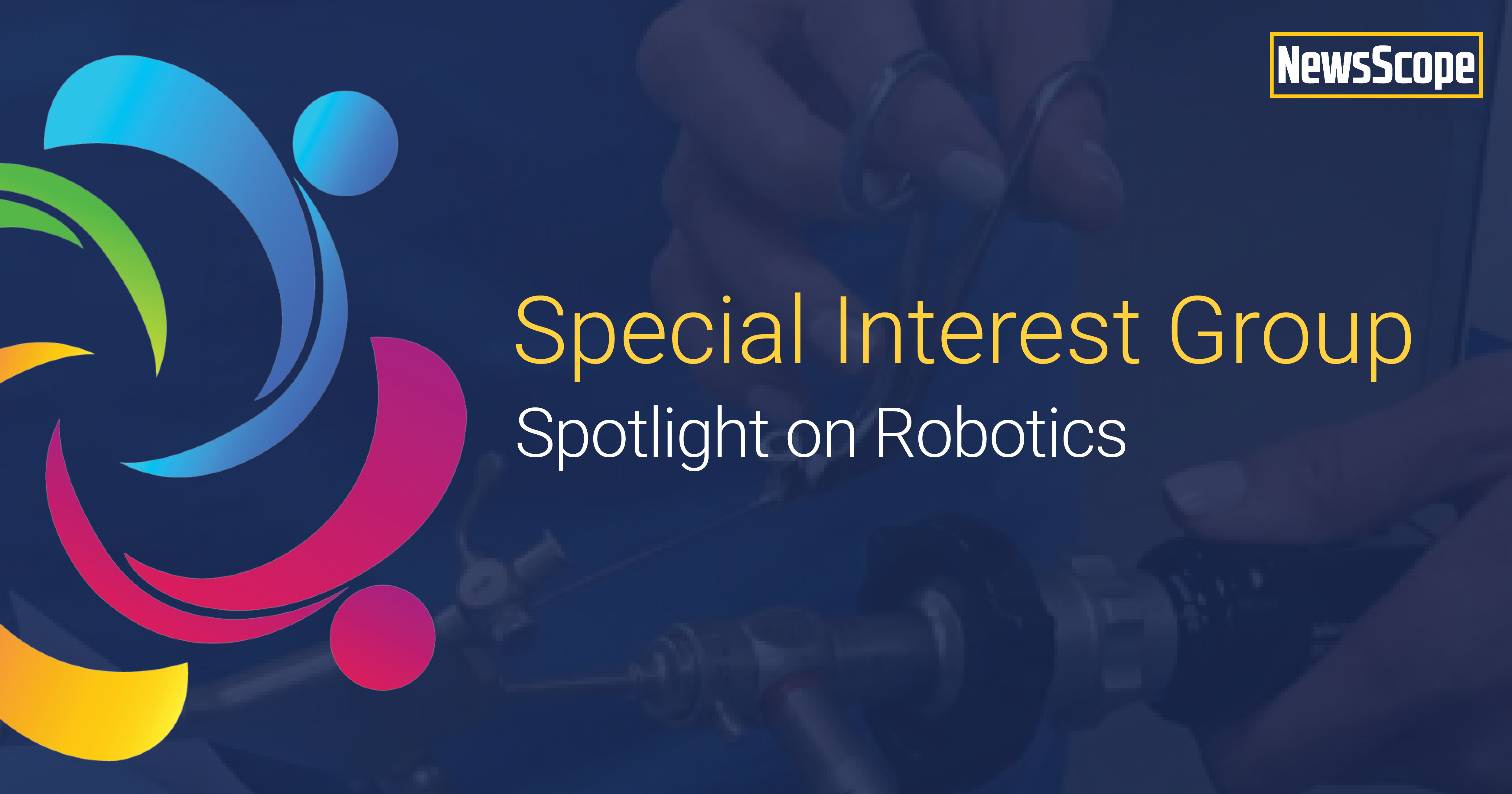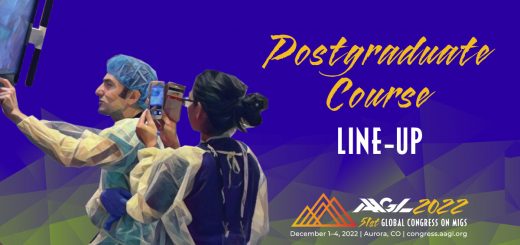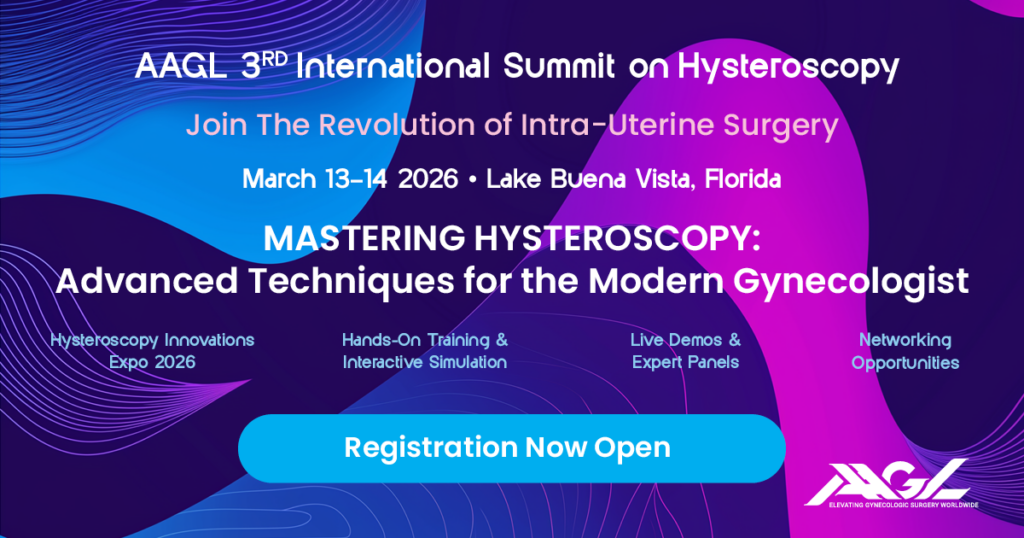Spotlight On: Robotics

This month we are spotlighting articles from the Robotics Special Interest Group led by Arleen Song, MD, Chair and and Peter Lim, MD, Vice Chair. SurgeryU features hundreds of high-definition surgical videos from surgeons from around the world. Access to SurgeryU is one of the many benefits included in your AAGL membership. If you would like access to these videos, CME programming, JMIG Journal, and member-only discounts on meetings, join AAGL today. These videos are being made available with public access for a limited time. Click here to join AAGL!
Spotlight Video by Khara M. Simpson, MD
“Laparoscopic Myomectomy: When & How?” presented by Drs. Bennett and Woo is an excellent foundational video that reviews general considerations for surgical planning for myomectomy including obtaining relevant imaging and determining the appropriate route of surgery. They also share their 5-step surgical tutorial using the robotic platform. They highlight the use of intracavitary methylene blue to delineate the endometrial borders to avoid injury during fibroid dissection.
Video: Laparoscopic Myomectomy
Author: Khara M. Simpson, MD is a Robotics SIG Board Member and Assistant Professor of Gynecology and Obstetrics and Minimally Invasive GYN Surgery at Johns Hopkins Hospital in Maryland.
Article: Most Difficult Case Presentation: 20 Weeks Venous Leiomyomatosis Uterus by PC Lim, MD FACOG, FACS
Venous leiomyomatosis of uterus (VLM) is a rare disease that is histologically benign but clinically aggressive. It is characterized by tumor growth into the venous channels of the myometrium and parametrium. However, extensive intravascular involvement has been reported with both cardiac and pulmonary extension observed in rare instances [1,2]. The treatment is complete surgical excision as reported by Mahmoud et al [3].
We report our most difficult and challenging case of VLM of a 49-year-old female who presented with a complaint of abdominal pain and heavy menstrual cycles. A pelvic ultrasound confirmed an 18-week leiomyoma uterus. MRI of the pelvis showed a multilobulated uterine mass, extending exophytically into the right lower abdomen, with evidence of venous tumor extension along the right periuterine veins and right gonadal vein adjacent to the ovary (Figure 1).

Figure 1 MRI of the abdomen and pelvic coronal view.
Robotic-assisted hysterectomy with right ureterolysis was performed. The posterior broad leaf ligament was incised and the pararectal space developed. The ureter was identified, and the ovarian vessels are skeletonized, coagulated, and divided. The medial leaf of the posterior broad leaf ligament peritoneum was incised distally to the level of the uterosacral ligament. The round ligament was divided followed by the anterior broad leaf ligament. The ureterovesical reflection was incised and the bladder was dissected away from the vagina. To safely resect the parametrial VLM, ureterolysis was necessary. The ureter was mobilized laterally from its medial leaf attachment of the posterior broad ligament peritoneum and the Okabayashi space was developed. The uterine artery and the deep uterine vein were identified branching from the anterior division of the internal iliac vessels. Following skeletonization, the uterine artery and vein were isolated, and divided. Ureterolysis was performed by unroofing the anterior ureterovesical ligament (AUVL). A sponge stick or EEA sizer was placed in the vaginal canal and cephalad traction was provided to mobilize the cervix away from the bladder. The ureter was followed into the ureterovesical junction to ensure that it was not compromised. After assuring the mobilization of the bladder below the level of the upper vagina dissected away from the vagina a colpotomy was made to complete the hysterectomy. The specimen was placed in an Endo Bag and removed through the vagina [Video 1].
Total operative time was 186 minutes and EBL was 100cc. Same day discharge was achieved without any complications. She is 3.5 years disease-free since surgery.
Video: Robotic Hysterectomy with Venous Leiomyomatosis
References:
- Kocica MJ, Vranes MR, Kostic D et al (2005) Intravenous leiomyomatosis with extension to the heart: rare or underestimated? J Thorac Cardiovasc Surg 130(6):1724–1726 40.
- Andrade LA, Torresan RZ, Sales JF Jr, Vicentini R, De Souza GA (1998) Intravenous leiomyomatosis of the uterus: a report of three cases. Pathol Oncol Res 4(1):44–47
- Mahmoud MS, Desai K, Nezhat FR. Leiomyomas beyond the uterus; benign metastasizing leiomyomatosis with paraaortic metastasizing endometriosis and intravenous leiomyomatosis: a case series and review of the literature. Arch Gynecol Obstet. 2015 Jan;291(1):223-30. doi: 10.1007/s00404-014-3356-8. Epub 2014 Jul 22. PMID: 25047270.
Author: Dr. Lim is Vice-Chair of the AAGL Robotics SIG, Medical Director of Gynecologic Oncology and Minimally Invasive Robotic Surgery at the Center of Hope and Clinical Associate Professor at the University of Nevada Reno School of Medicine in Nevada.
Technology Review: Robotics SIG Tech Update: 3D Uterine Modeling by Erica Stockwell, DO, MBA, FACOG
We are living in an age of technological boom. It is changing the way we interact, entertain and even how we are cured. Robotics is an example of how technology bolsters excellence in surgery and healthcare. One of the most exciting advances today is the adoption of augmented and virtual reality into medicine. Virtual reality (VR) is a technology that immerses the user in a synthetic 3-dimensional (3D) environment via wearable screens in the form of VR headsets, while augmented reality (AR) uses elements of VR and superimposes them onto the real-world environment in the form of a live video displayed on the screen of an electronic device [1]. VR is a concept that has been developing over the last 50 years, whereas AR is a relatively new concept. These technologies allow physicians to better treat patients, explain diagnoses, teach learners, and prepare for surgery.
Medical imaging such as ultrasound, computed tomography (CT) and magnetic resonance imaging (MRI) are often used as part of pre-surgical planning, but not all surgeons have the expertise to read these 2D images in a way to optimize their use during surgery. Anatomical comprehension can be improved by using digital 3D models. This is especially true for pre-surgical planning of complex myomectomies. Using 3D VR models of uterine fibroids allows surgeons to see the relationship of the tumors with the endometrium and surrounding myometrium, which in turn may lead to reduced surgical time and blood loss, while also helping to preserve the integrity of the endometrial lining.
The general workflow for creating these models begins with data from MRI or CT. These data are stored in a DICOM (digital imaging and communications in medicine) file format. This is followed by a process whereby these files are segmented, labeled, and the anatomy of interest is isolated and identified. From there, a combination of algorithms and manual verification traces the anatomy of interest on each image. Once completed, these images are converted into 3D digital models. Users can specify parameters such as colors and whether anatomically related objects are shown individually or together [2, 3, 4]. The 3D model can then be viewed and manipulated on a computer, tablet, or cell phone. During surgery, the model can be loaded onto TileProTM on the da Vinci® surgeon console to replicate the live view.
In addition to myomectomies, 3D VR models may assist in pre-surgical planning of complex hysterectomies, endometriosis, adenomyosis, Mullerian defects, isthmoceles, and other pelvic masses. 3D models may also augment patient education, as models can be used by clinicians to help patients understand their pathology and plan of care.
3D VR models in surgical planning of several types of procedures across other specialties have demonstrated reduced operative time, estimated blood loss, and length of hospital stay [5, 6]. Further investigation still needs to be performed to determine if 3D VR models for operative planning of gynecologic procedures would affect similar key surgical outcomes.

References:
[1] Yeung A, Tosevska A, Klager E, Eibensteiner F, Laxar D, Stoyanov J, Glisic M, Zeiner S, Kulnik S, Crutzen R, Kimberger O, Kletecka-Pulker M, Atanasov A, Willschke H. Virtual and Augmented Reality Applications in Medicine: Analysis of the Scientific Literature. J Med Internet Res. 2021 Feb;23(2): e25499.
[2] Armano G, Barbuto S, Wagner S, Carugno J, Bifulco G, Di Spiezio Sardo A. Incorporating 3D reconstruction in preoperative surgical planning of Multiple Myomectomy. Facts, Views and Vision in ObGyn. 2022 Mar;14(1):87-89.
[3] Ra Lee S, Jae Kim Y, Gi Kim K. A Fast 3-Dimensional Magnetic Resonance Imaging Reconstruction for Surgical Planning of Uterine Myomectomy. J Korean Med Sci. 2018 Jan 8;33(2):e12.
[4] Reddy H, Maghsoudlou P, Pepin K, Clark NV, Cohen SL, Einarsson JI. Use of 3D Model in Laparoscopic Myomectomy. JMIG. 2019;26(7):S19.
[5] Shirk J, Thiel D, Wallen E, Linehan J, White W, Badani K, Porter J. Effect of 3-Dimensional Virtual Reality Models for Surgical Planning of Robotic-Assisted Partial Nephrectomy on Surgical Outcomes. JAMA Netw Open. 2019;2(9):e1911598.
[6] Boedecker C, Huettl F, Saalfeld P, Paschold M, Kneist W, Baumgart J, Preim B, Hansen C, Lang H, Huber T. Using virtual 3D-models in surgical planning: workflow of an immersive virtual reality application in liver surgery. Langenbecks Arch Surg. 2021 May;406(3):911-915.
Author: Dr. Stockwell is a Robotics SIG Board member, DO at AdventHealth Medical Group Central Florida Division and Gynecologic Surgeon at GYN Surgery at Celebration in Celebration, Florida.








